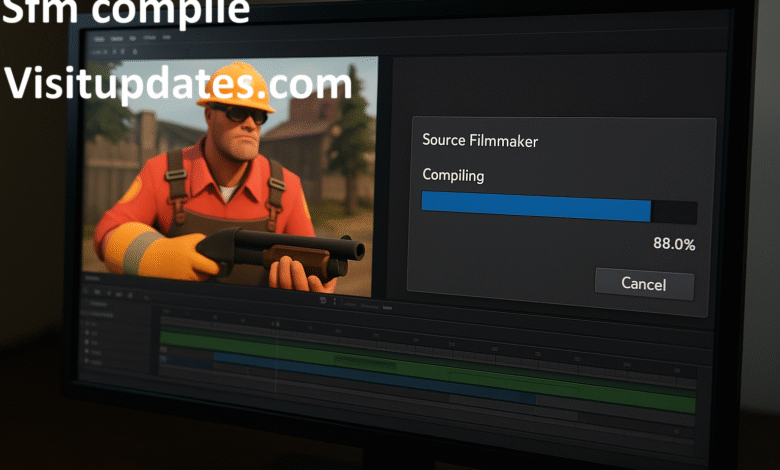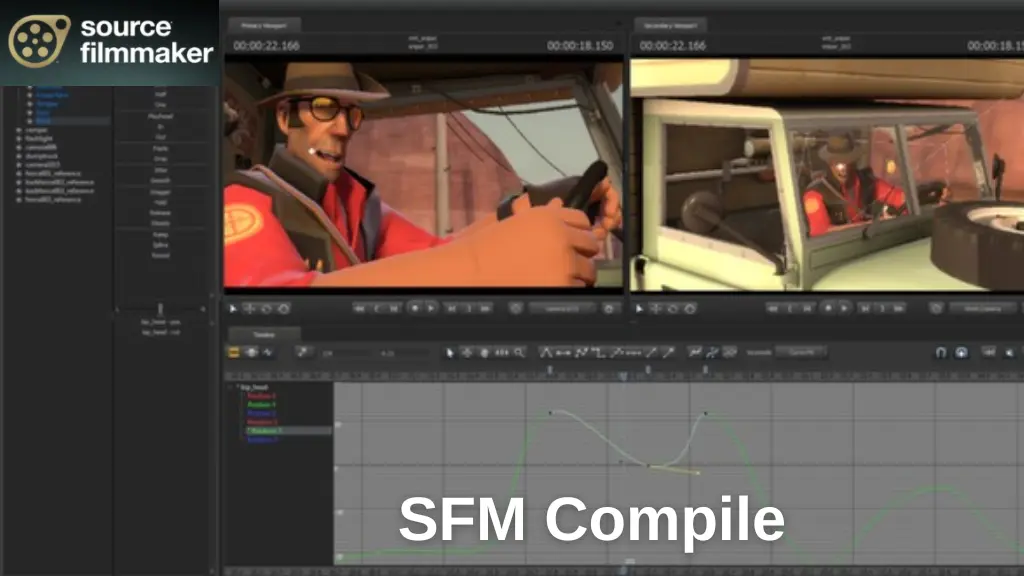SFM Compile Explained: Master the Process to Render Smooth and Error-Free Animations

If you’ve spent any time creating animations in Source Filmmaker, you’ve probably encountered the term “SFM compile” more than once. Whether you’re a beginner trying to export your first project or an experienced animator troubleshooting rendering issues, understanding the compilation process is absolutely essential. The SFM Compile stage is where your creative vision transforms from a working session file into a polished, shareable video format. Getting this process right means the difference between smooth, professional-looking animations and frustrating error messages that stop you dead in your tracks.
What Is SFM Compile and Why Does It Matter?
The SFM compile process is essentially the rendering phase where Source Filmmaker processes all your animation data, lighting, effects, and camera movements to create a final video file. During compilation, the software reads through every frame of your project, applies all the rendering settings you’ve specified, and exports the result as a movie file or image sequence. This isn’t just a simple export button click—it’s a complex computational SFM Compile process that requires your system to handle multiple layers of information simultaneously.
What makes understanding SFM compile so important is that this stage often reveals issues that weren’t apparent during the animation phase. You might have motion blur settings that conflict with your frame rate, lighting that causes unexpected artifacts, or particle effects that don’t render correctly. Mastering the compile process helps you anticipate these problems, configure your settings optimally, and troubleshoot errors efficiently when they inevitably appear.
Understanding the Source Filmmaker Rendering Pipeline
Before diving into the compilation process itself, you need to understand how Source Filmmaker’s rendering pipeline works. SFM operates on Valve’s Source engine, which means it uses a game engine architecture to create cinematic content. When you’re working in the viewport, you’re seeing a real-time preview that’s optimized SFM Compile for interactive editing, not final output quality. The compile process bridges this gap by applying high-quality rendering techniques that would be too performance-intensive for real-time editing.
The rendering pipeline involves several distinct stages: geometry processing, texture application, lighting calculations, shadow rendering, post-processing effects, and motion blur application. Each of these stages can be configured independently through various settings panels in SFM. Understanding this pipeline helps you diagnose where problems occur during compilation—if your renders are coming out too dark, for example, you know to SFM Compile examine your lighting settings rather than your geometry.
Essential Preparation Before Starting Your SFM Compile
Proper preparation is half the battle when it comes to successful compilation. Before you even think about hitting that render button, you need to ensure your project is properly organized and optimized. Start by thoroughly reviewing your animation in the viewport, checking for any clipping issues, incorrect model positioning, or animation glitches. These problems will carry through to your final render, and they’re much easier to fix in the editing stage than after compilation.
Next, consider your system resources and project complexity. Compilation is resource-intensive, and if your scene contains dozens of high-polygon models, complex particle systems, and multiple light sources, you’ll need to plan accordingly. Close unnecessary applications, ensure you have adequate free disk space for the output files, and be prepared for the compilation process to take significant time. A thirty-second animation with SFM Compile high-quality settings can easily take several hours to compile on a mid-range system.
Configuring Your Render Settings for Optimal Results

The render settings panel in SFM Compile Source Filmmaker gives you tremendous control over your final output quality, but it can be overwhelming if you don’t understand what each option does. The resolution setting determines your output dimensions—1920×1080 is standard for HD content, while 3840×2160 gives you 4K quality at the cost of significantly longer render times. Your frame rate choice typically sits at 24, 30, or 60 frames per second, with higher frame rates creating smoother motion but requiring more rendering time and larger SFM Compile file sizes.
Anti-aliasing settings are particularly important for eliminating jagged edges in your animation. SFM offers several anti-aliasing methods, with higher settings producing cleaner results but demanding more processing power. Motion blur settings add cinematic quality by simulating camera shutter speed, making fast movements appear more natural. However, improper motion blur configuration can cause ghosting artifacts or excessive blur that SFM Compile makes your animation look muddy. Start with moderate settings and adjust based on your specific scene requirements and aesthetic preferences.
Choosing the Right Export Format and Codec
Your choice of export format significantly impacts both the quality and compatibility of your final animation. Source Filmmaker supports several output options, including AVI files, image sequences (TGA or PNG), and various video codecs. For maximum quality and editing flexibility, many experienced animators prefer exporting as an image sequence, which creates individual frames that can be assembled in video editing software with complete control over compression and format.
If you’re exporting directly to video, codec selection becomes crucial. Uncompressed AVI files preserve perfect quality but create enormous file sizes—a single minute of 1080p footage can easily exceed several gigabytes. The H.264 codec offers excellent compression with minimal quality loss and remains the industry standard for most SFM Compile applications. For projects requiring transparency or further editing, consider formats that support alpha channels. Understanding codec options helps you balance file size, quality, and compatibility based on your specific distribution needs.
Common SFM Compile Errors and How to Fix Them
Even with perfect preparation, compilation errors happen, and knowing how to troubleshoot them saves enormous amounts of frustration. One of the most common issues is the “out of memory” error, which occurs when your system doesn’t have enough RAM to process the scene. This typically happens with complex scenes containing high-resolution textures and numerous models. The solution often involves simplifying your scene, reducing texture resolutions, or breaking your animation into smaller segments that can be compiled SFM Compile separately and merged later.
Another frequent problem involves missing textures or models that appear purple or checkerboard-patterned in the final render. This happens when SFM can’t locate required assets, usually because custom content wasn’t properly installed or file paths have changed. The fix requires verifying that all custom models and materials are correctly placed in your SFM directories and that any workshop content is properly subscribed and updated. Lighting errors, where scenes appear too bright or completely dark, typically stem from incorrectly configured light sources or ambient lighting settings that need adjustment in your scene setup.
Optimizing Compilation Speed Without Sacrificing Quality
Long render times are an inevitable part of animation work, but several strategies can help you optimize the compilation process without compromising your final quality. First, use progressive rendering approaches—start with low-quality test renders to verify that everything looks correct before committing to a full-quality compile. This lets you catch and fix issues early without wasting hours on renders that need to be redone.
Consider rendering in segments, especially for longer animations. Breaking a five-minute animation into ten thirty-second segments allows you to work more flexibly, making changes to specific sections without re-rendering the entire project. It also provides natural checkpoints where you can verify quality and catch errors before they propagate through the entire animation. Additionally, rendering overnight or during times when you’re not actively using your computer maximizes your productive time and ensures your system resources are fully dedicated to the compilation process.
Advanced Techniques for Professional-Quality Renders
Once you’ve mastered the basics of SFM compile, several advanced techniques can elevate your animations to professional quality. Multi-pass rendering involves compiling different elements of your scene separately—characters, backgrounds, effects—and compositing them together in post-production software. This approach gives you tremendous control over individual elements and makes it easier to make targeted adjustments without re-rendering entire scenes.
Depth of field effects, which blur foreground or background elements to simulate camera focus, add cinematic quality but require careful configuration during compilation. These effects are computationally expensive and can significantly increase render times, but they’re essential for achieving that polished, professional look. Similarly, proper motion blur configuration requires understanding shutter angle settings and how they interact with your animation’s movement speed. Experimenting with these settings and studying how professional animators use them helps you develop an eye for quality and understand what makes rendered animations feel premium.
Post-Compilation Workflow and Quality Control
Your work doesn’t end when the compilation finishes. Implementing a thorough quality control process ensures your final animation meets your standards before you share it publicly. Watch your compiled animation completely at least once, preferably multiple times, looking for different types of issues each time—first for technical problems like stuttering or artifacts, then for artistic issues like timing or composition problems.
Check your audio sync if you’ve included sound, verify that any text or UI elements are readable and positioned correctly, and ensure colors appear consistent throughout the animation. If you’ve rendered as an image sequence, this is the stage where you’ll import those frames into video editing software, apply any final color correction or effects, and encode to your final distribution format. Many animators also create multiple output versions at this stage—a high-quality archive version, a compressed version for online sharing, and perhaps a 4K version for future-proofing their work.
Troubleshooting Specific Rendering Artifacts
Understanding common rendering artifacts helps you quickly identify and resolve quality issues in your compiled animations. Flickering typically occurs when lighting isn’t properly baked or when anti-aliasing settings are insufficient for small details. Z-fighting, where two surfaces occupy the same space and flicker between visibility, requires adjusting model positions or camera angles to eliminate the overlap.
Banding in gradients or skies indicates insufficient color bit depth and can be resolved by adjusting your export settings or adding subtle noise in post-production. Shadow artifacts often result from shadow map resolution settings that are too low for your scene complexity. Texture streaming issues, where textures appear blurry or take time to load in, usually indicate memory constraints that require reducing texture quality or simplifying the scene. Learning to recognize these artifacts by sight and knowing their typical causes accelerates your troubleshooting process significantly.
Best Practices for Large-Scale Animation Projects
Working on ambitious projects with multiple scenes and complex animations requires strategic planning around the compilation process. Establish a consistent naming convention and folder structure for your rendered outputs—this seems trivial until you’re managing hundreds of rendered segments and need to quickly locate specific sections for revisions. Maintain detailed notes about render settings used for each scene to ensure consistency across your entire project.
Consider creating a rendering pipeline that includes regular backups and archiving of both source files and rendered outputs. Hard drive failures or corrupted files are devastating when they occur after hours of rendering. Many professional animators use dedicated rendering machines or cloud rendering services for particularly complex projects, freeing up their main workstation for continued creative work while compilation happens in parallel. Even if you’re working on a single computer, batching your renders and planning your work schedule around compilation times helps maximize productivity.
Mastering SFM Compile for Long-Term Success
The SFM compile process might seem daunting initially, but understanding its mechanics, properly configuring your settings, and developing efficient workflows transforms it from a frustrating bottleneck into a manageable part of your animation pipeline. The key is approaching compilation systematically—prepare thoroughly, test incrementally, and learn from each render to continuously improve your process. Every animation project teaches you something new about optimization, quality settings, and troubleshooting that makes future projects smoother.
Remember that even experienced animators encounter compilation issues and spend time troubleshooting renders. The difference is they’ve developed the knowledge and experience to diagnose problems quickly and implement solutions efficiently. By mastering the SFM compile process, you’re not just learning technical skills—you’re developing the problem-solving abilities and attention to detail that define professional animation work. Your compiled animations represent the culmination of your creative vision, technical skill, and patience, and understanding this process ensures that vision translates accurately from concept to finished product.



